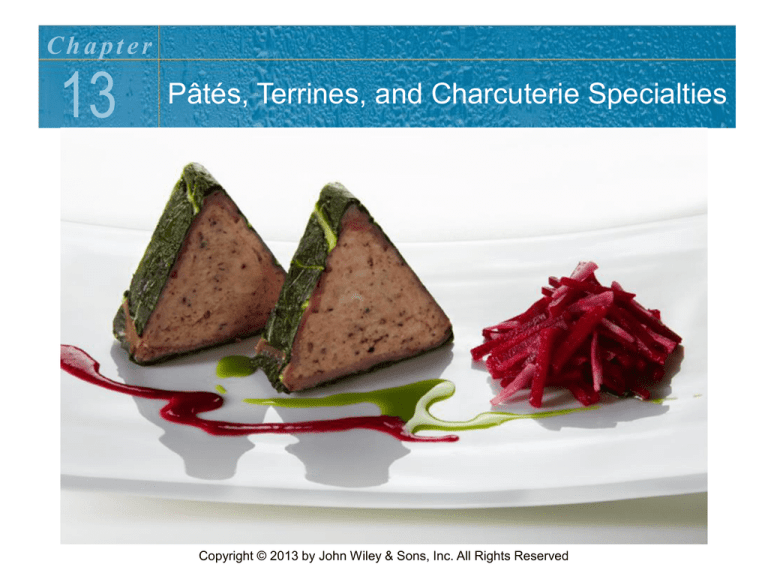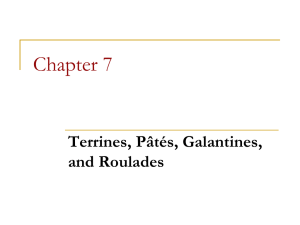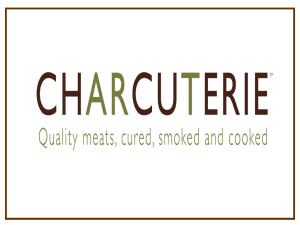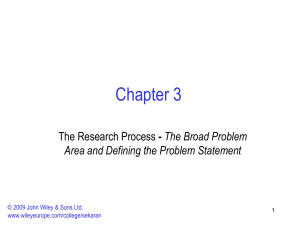
Chapter
13
Pâtés, Terrines, and Charcuterie Specialties
Copyright © 2013 by John Wiley & Sons, Inc. All Rights Reserved
Chapter
13
Pâtés, Terrines, and Charcuterie Specialties
Chapter Pre-Requisites
Before Studying this chapter, you should already:
• Have read “How to Use This Book,” pages xxviii-xxxiii, and
understand the professional recipe format.
• Know basic meat and poultry cuts, and be proficient at fabricating
them.
• Be familiar with various spices, and know how to toast and grind
whole spices.
• Be proficient at clarifying stock.
Copyright © 2013 by John Wiley & Sons, Inc. All Rights Reserved
Chapter
13
Pâtés, Terrines, and Charcuterie Specialties
Chapter Pre-Requisites
Before Studying this chapter, you should already:
• Have read Chapter 11, “Cured and Smoked Foods,” and understand
the use of curing mixtures.
• Have read Chapter 12, “Sausages,” know the various types of pork
fat, and be proficient at preparing standard-grind forcemeats.
• Know how to work with gelatin if you will be preparing pâtés en
croûte, or have read ahead to Chapter 16, “Aspic and Chaud-Froid,”
pages 632-635.
Copyright © 2013 by John Wiley & Sons, Inc. All Rights Reserved
Chapter
13
Pâtés, Terrines, and Charcuterie Specialties
Chapter Objectives
After reading this chapter, you should be able to:
•
•
•
•
•
•
List and describe the five basic types of pâté.
List and describe the four elements of pâté construction.
Identify and safely use the proper equipment for pâté production.
Prepare pâté forcemeats.
Correctly assemble various types of pâté.
Cook pâté products to the proper internal doneness and finish them
appropriately according to type.
• Prepare complementary sauces, condiments, and accompaniments
for pâtés.
• Present finished pâté products for both plated service and platter
service.
Copyright © 2013 by John Wiley & Sons, Inc. All Rights Reserved
Chapter
13
Pâtés, Terrines, and Charcuterie Specialties
Pâtés and Terrines
Pâté
• A pâté
is a forcemeat baked in a pastry crust and usually served
cold—this technical, culinary definition is the one generally accepted
among chefs and food-service professionals worldwide.
• However, to the average North American consumer, the definition is
much broader, encompassing pâtés with and without crusts as well
as spread-like mixtures and cold seafood mousselines.
• Today, the term pâté can even include loaf like cold vegetable
preparations.
Copyright © 2013 by John Wiley & Sons, Inc. All Rights Reserved
Chapter
13
Pâtés, Terrines, and Charcuterie Specialties
Pâtés and Terrines
Types of Pâtés
• Today there are five basic types of pâtés:
1. Pâté en croûte
: a forcemeat baked in a crust of pastry dough.
2. Terrine
: a forcemeat baked in a form or vessel without a
pastry crust.
3. Galantine
and ballotine
: forcemeats wrapped in poultry
skin or meat.
4. Pâté roulade
(or pâté en roulade): assembled and cooked in
the same way as a galantine, but not wrapped in a poultry skin.
5. Mousseline pâté
: The smoothest and most refined form of
pâté made from an emulsion of puréed raw meat, eggs, and
cream.
Copyright © 2013 by John Wiley & Sons, Inc. All Rights Reserved
Chapter
13
Pâtés, Terrines, and Charcuterie Specialties
Pâtés and Terrines
The Four Elements of Pâté Construction
• Most pâtés have four basic elements:
1.
2.
Forcemeat: All pâtés begin with a forcemeat. This emulsified
mixture of ground meat and fat makes up the body of the pâté.
Internal garnishes: Pieces of food placed within the forcemeat
to add texture, flavor, and visual interest.
Copyright © 2013 by John Wiley & Sons, Inc. All Rights Reserved
Chapter
13
Pâtés, Terrines, and Charcuterie Specialties
Pâtés and Terrines
The Four Elements of Pâté Construction
• Most pâtés have four basic elements:
3. Liners and wrappers: A pâté forcemeat is usually contained in
some form of wrapper or liner.
•
Only mousselines are not wrapped or lined; they may be encased
in a colorful vegetable wrapper for an attractive presentation.
4. Sealers: Historically, after a pâté product was baked and
cooled, it was sealed with a semisolid fat to preserve it. Modern
pâtés and terrines are now more often sealed with aspic for
presentation purposes.
•
Lard, rendered poultry fat, butter, and aspic are used as pâté
sealers.
Copyright © 2013 by John Wiley & Sons, Inc. All Rights Reserved
Chapter
13
Pâtés, Terrines, and Charcuterie Specialties
Pâtés and Terrines
Ingredients
• Primary meats: Meats that must total more than half the
pâté forcemeat’s weight.
• Secondary meats: Meats added to a pâté forcemeat.
They are used for a number of reasons:
1. To add a rich mouthfeel to a forcemeat made from a lean
primary meat. Both pork and liver are used for this purpose.
2. To lighten the color of the finished product.
Copyright © 2013 by John Wiley & Sons, Inc. All Rights Reserved
Chapter
13
Pâtés, Terrines, and Charcuterie Specialties
Pâtés and Terrines
Meats and poultry frequently used in pâté forcemeats:
•
•
•
•
•
•
•
•
•
•
Pork
Turkey
Pork liver
Veal
Duck
Calf’s liver
Game meats
Wildfowl
Chicken
Poultry livers
Copyright © 2013 by John Wiley & Sons, Inc. All Rights Reserved
Chapter
13
Pâtés, Terrines, and Charcuterie Specialties
Pâtés and Terrines
Fats for Pâté Forcemeats
• Fresh pork fat
• Chicken fat and turkey fat
• Duck fat
Seasonings for Pâté Forcemeats
• Salt, spices, herbs, aromatic vegetables, meat glazes,
alcoholic beverages, nitrite curing mix.
Copyright © 2013 by John Wiley & Sons, Inc. All Rights Reserved
Chapter
13
Pâtés, Terrines, and Charcuterie Specialties
Pâtés and Terrines
Secondary Binders and Extenders for Pâté Forcemeats
• Many forcemeats acquire a better texture with a secondary binding
element in addition to the primary bind created by the emulsion of fat
and meat.
• These secondary binders consist of protein ingredients and starch
ingredients.
• The starch binders also function as extenders, adding low-cost bulk
to the force meat mix.
Secondary binders used in pâté forcemeats include:
• Raw egg
• Flour
• Panade (or Panada)
Copyright © 2013 by John Wiley & Sons, Inc. All Rights Reserved
Chapter
13
Pâtés, Terrines, and Charcuterie Specialties
Pâtés and Terrines
Ingredients for Pâté Internal Garnishes
•
•
•
•
•
•
•
Cured and smoked meats
Nuts
Dried fruits and vegetables
Truffles
Marinated raw meats and poultry
Seasoned livers
Gratin garnishes: Raw meats and poultry or livers that are seared to add
both flavor and an attractive brown color to the finished pâté product.
Internal garnishes are applied to pâtés in two ways:
1. Random garnishes
2. Inlay Garnishes
Copyright © 2013 by John Wiley & Sons, Inc. All Rights Reserved
Chapter
13
Pâtés, Terrines, and Charcuterie Specialties
Pâtés and Terrines
Wrappings and Linings for Pâtés
• Pâte à pâté
croûte
: Pastry dough wrappers for pâtés en
– The French translation for this terms is “pastry for pâté.”
– These doughs must be sturdy enough to hold up to heavy
forcemeats and the steam, juices, and rendered fat they
produce.
– Dough choices include:
• Pâte brisée
, made with lard or vegetable shortening.
• A milk-enriched biscuit-type dough.
• A lightly yeasted, lard-enriched bread dough.
Copyright © 2013 by John Wiley & Sons, Inc. All Rights Reserved
Chapter
13
Pâtés, Terrines, and Charcuterie Specialties
Pâtés and Terrines
Wrappings and Linings for Pâtés
• Liners for terrines
– Fresh pork fatback
• Fatback used for lining terrines must be fabricated into long, wide,
even slices, 1⁄8-in. (0.3-cm) thick, to line the terrine mold thoroughly
and efficiently.
– Caul fat (also called lace fat)
• A thin yet remarkably strong membrane that encases the stomach
and intestines of hogs and other animals.
Copyright © 2013 by John Wiley & Sons, Inc. All Rights Reserved
Chapter
13
Pâtés, Terrines, and Charcuterie Specialties
Pâtés and Terrines
Wrappings and Linings for Pâtés
• Liners for terrines
– Bacon or pancetta is the usual liner choice of amateur cooks as both are
widely available in pre-sliced form.
– However, the assertive taste of these products can overwhelm the flavor
of a delicate forcemeat.
– They are best teamed with bold, rustic forcemeats, particularly those that
include liver.
Danish liver pâté
with bacon
Copyright © 2013 by John Wiley & Sons, Inc. All Rights Reserved
Chapter
13
Pâtés, Terrines, and Charcuterie Specialties
Pâtés and Terrines
Wrappings and Linings for Pâtés
• Liners for terrines
– Vegetables, such as sturdy lettuce leaves, mild-flavored
cabbage, kale, and blanched leeks, may be used as liners for
modern poached or steamed terrines.
Provençal Terrine of Rabbit
Copyright © 2013 by John Wiley & Sons, Inc. All Rights Reserved
Chapter
13
Pâtés, Terrines, and Charcuterie Specialties
Pâtés and Terrines
Sealer Ingredients for Pâtés
• Aspic Sealer for Pâtés en Croûte
– For pâtés en croûte, modern charcutiers
use flavorful, crystal-clear aspic to fill the
gap and adhere the crust to the
forcemeat.
– Lard is the traditional material used to
seal terrines for extended storage.
Copyright © 2013 by John Wiley & Sons, Inc. All Rights Reserved
Chapter
13
Pâtés, Terrines, and Charcuterie Specialties
Equipment for Pâté Production
Equipment for Grinding and Puréeing
•
Pâté forcemeats are prepared in the
same manner as sausage forcemeats.
Therefore, the same equipment is used
for grinding and puréeing both.
Pâté and Terrine Forms
•
Today’s charcutiers can choose from a
variety of vessels in which to bake both
pâtés en croûte and terrines.
From top to bottom:
Stainless-steel triangle form,
enameled cast-iron terrine,
porcelain terrine,
stainless-steel collapsible pâté en croûte form
Copyright © 2013 by John Wiley & Sons, Inc. All Rights Reserved
Chapter
13
Pâtés, Terrines, and Charcuterie Specialties
Preparing Pâtés and Terrines
• Because both sausages and pâtés begin with forcemeats, the initial
preparation of pâtés is the same as sausages.
• Information on the preparation of forcemeats can be found in
Chapter 12, pages 482-490.
Copyright © 2013 by John Wiley & Sons, Inc. All Rights Reserved
Chapter
13
Pâtés, Terrines, and Charcuterie Specialties
Galantines, Ballotines and Pâté Roulades
Galantine or Ballotine?
• Galantine
– Most food historians believe the culinary term galantine is derived from
the archaic French word galine, meaning “chicken,” and is related to
the modern Spanish word for chicken, gallina.
– If this is the true linguistic root of the term, it is safe to assume that a
galantine should be made from a chicken, or from a kind of fowl.
• Ballotine
– The term ballotine is also frequently used to describe a poultry
forcemeat cooked in a poultry skin.
– However, this term is derived from the French ballot, or “bundle,” and
so is more generic than galantine. Thus, it can refer to any kind of
wrapped forcemeat.
Copyright © 2013 by John Wiley & Sons, Inc. All Rights Reserved
Chapter
13
Pâtés, Terrines, and Charcuterie Specialties
Galantines, Ballotines and Pâté Roulades
Galantine or Ballotine?
• Both galantines and ballotines
consist of forcemeats wrapped in
skin or meat prior to cooking.
• Pâté roulades are modern
interpretations of galantines and
ballotines.
• The poultry skin is replaced by a
decorative liner, and the lined
forcemeat is wrapped in heavyduty plastic film before it is
poached.
Copyright © 2013 by John Wiley & Sons, Inc. All Rights Reserved
Chapter
13
Pâtés, Terrines, and Charcuterie Specialties
Storing and Presenting Pâtés
Storage
• Most pâté products, once sealed as in the preceding procedures,
have a relatively long refrigerated shelf life.
• A terrine untouched in its dish keeps in the refrigerator for a month,
while an uncut, aspic-sealed pâté en croûte lasts at least two weeks.
• Once a pâté product is cut open, it must be served within a few
days.
• Although you can freeze uncooked pâté forcemeat and even freeze
an uncooked, assembled terrine, you cannot successfully freeze
a cooked pâté.
Copyright © 2013 by John Wiley & Sons, Inc. All Rights Reserved
Chapter
13
Pâtés, Terrines, and Charcuterie Specialties
Storing and Presenting Pâtés
Presentation Styles
• Pâtés, terrines, and galantines
may be:
– presented on a platter for buffet
service.
– individually portioned for plate service.
• Platter Presentation
pâté en croûte
– A well-crafted pâté en croûte, terrine,
galantine, or roulade is often the
centerpiece of a garde manger
display.
Copyright © 2013 by John Wiley & Sons, Inc. All Rights Reserved
Chapter
13
Pâtés, Terrines, and Charcuterie Specialties
Storing and Presenting Pâtés
Presentation Styles
• Plate Presentation
– Plated presentation can range
from simple and rustic to
elaborate and formal.
– In simple, traditional
presentations, one or two
slices of pâté are plated with a
liner leaf or herb sprig garnish,
a condiment, and perhaps a
simple or composed salad
accompaniment.
Provençal Terrine of
Rabbit with Beet Salad
Copyright © 2013 by John Wiley & Sons, Inc. All Rights Reserved
Chapter
13
Pâtés, Terrines, and Charcuterie Specialties
Storing and Presenting Pâtés
Presentation Styles
• En Terrine Presentation
– For casual service, a terrine may be served in the same dish in
which it was baked, a service style called en terrine presentation.
Country terrine
presented in an
enameled cast-iron
terrine dish
Copyright © 2013 by John Wiley & Sons, Inc. All Rights Reserved
Chapter
13
Pâtés, Terrines, and Charcuterie Specialties
Storing and Presenting Pâtés
Pâté Accompaniments
• Good bread is the essential accompaniment for pâtés.
• Ideas for pâté accompaniments.
–
–
–
–
–
–
–
–
–
Flavored mustards
Cumberland sauce
Anglo-Indian chutneys
Mayonnaise sauces
Relishes
Fruit or vegetable salsas
Reduced vinegar glazes
Pickled vegetables
Vegetables dressed in vinaigrette
Copyright © 2013 by John Wiley & Sons, Inc. All Rights Reserved










